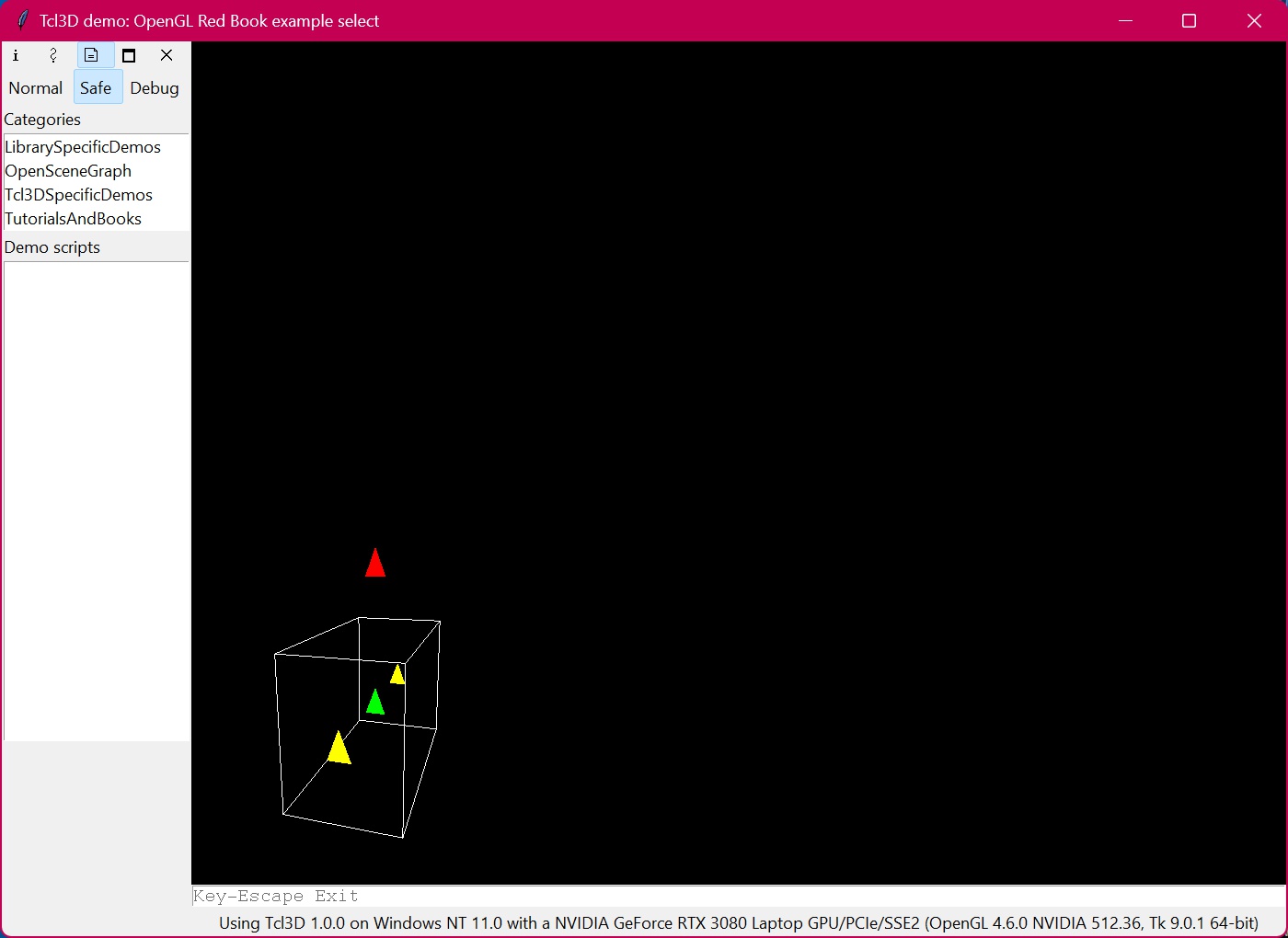Demo 51 of 68 in category RedBook
 |
# select.tcl
#
# An example of the OpenGL red book modified to work with Tcl3D.
# The original C sources are Copyright (c) 1993-2003, Silicon Graphics, Inc.
# The Tcl3D sources are Copyright (c) 2005-2025, Paul Obermeier.
# See file LICENSE for complete license information.
#
# This is an illustration of the selection mode and
# name stack, which detects whether objects which collide
# with a viewing volume. First, four triangles and a
# rectangular box representing a viewing volume are drawn
# (drawScene routine). The green triangle and yellow
# triangles appear to lie within the viewing volume, but
# the red triangle appears to lie outside it. Then the
# selection mode is entered (selectObjects routine).
# Drawing to the screen ceases. To see if any collisions
# occur, the four triangles are called. In this example,
# the green triangle causes one hit with the name 1, and
# the yellow triangles cause one hit with the name 3.
package require tcl3d
tcl3dConsoleCreate .tcl3dOutputConsole "# " "Select Output"
set BUFSIZE 512
set selectBuffer [tcl3dVector GLuint $::BUFSIZE]
# Font to be used in the Tk listbox.
set listFont {-family {Courier} -size 10}
# Show errors occuring in the Togl callbacks.
proc bgerror { msg } {
tk_messageBox -icon error -type ok -message "Error: $msg\n\n$::errorInfo"
exit
}
# Print info message into widget a the bottom of the window.
proc PrintInfo { msg } {
if { [winfo exists .fr.info] } {
.fr.info configure -text $msg
}
}
# draw a triangle with vertices at (x1, y1), (x2, y2)
# and (x3, y3) at z units away from the origin.
proc drawTriangle { x1 y1 x2 y2 x3 y3 z } {
glBegin GL_TRIANGLES
glVertex3f $x1 $y1 $z
glVertex3f $x2 $y2 $z
glVertex3f $x3 $y3 $z
glEnd
}
# draw a rectangular box with these outer x, y, and z values
proc drawViewVolume { x1 x2 y1 y2 z1 z2 } {
set negz1 [expr -1.0 * $z1]
set negz2 [expr -1.0 * $z2]
glColor3f 1.0 1.0 1.0
glBegin GL_LINE_LOOP
glVertex3f $x1 $y1 $negz1
glVertex3f $x2 $y1 $negz1
glVertex3f $x2 $y2 $negz1
glVertex3f $x1 $y2 $negz1
glEnd
glBegin GL_LINE_LOOP
glVertex3f $x1 $y1 $negz2
glVertex3f $x2 $y1 $negz2
glVertex3f $x2 $y2 $negz2
glVertex3f $x1 $y2 $negz2
glEnd
glBegin GL_LINES ; # 4 lines
glVertex3f $x1 $y1 $negz1
glVertex3f $x1 $y1 $negz2
glVertex3f $x1 $y2 $negz1
glVertex3f $x1 $y2 $negz2
glVertex3f $x2 $y1 $negz1
glVertex3f $x2 $y1 $negz2
glVertex3f $x2 $y2 $negz1
glVertex3f $x2 $y2 $negz2
glEnd
}
# drawScene draws 4 triangles and a wire frame
# which represents the viewing volume.
#/
proc drawScene {} {
glMatrixMode GL_PROJECTION
glLoadIdentity
gluPerspective 40.0 [expr 4.0/3.0] 1.0 100.0
glMatrixMode GL_MODELVIEW
glLoadIdentity
gluLookAt 7.5 7.5 12.5 2.5 2.5 -5.0 0.0 1.0 0.0
glColor3f 0.0 1.0 0.0 ; # green triangle
drawTriangle 2.0 2.0 3.0 2.0 2.5 3.0 -5.0
glColor3f 1.0 0.0 0.0 ; # red triangle
drawTriangle 2.0 7.0 3.0 7.0 2.5 8.0 -5.0
glColor3f 1.0 1.0 0.0 ; # yellow triangles
drawTriangle 2.0 2.0 3.0 2.0 2.5 3.0 0.0
drawTriangle 2.0 2.0 3.0 2.0 2.5 3.0 -10.0
drawViewVolume 0.0 5.0 0.0 5.0 0.0 10.0
}
# processHits prints out the contents of the selection array
#
proc processHits { hits } {
set count 0
puts "hits = $hits"
for { set i 0 } { $i < $hits } { incr i } {
set names [$::selectBuffer get $count]
puts " number of names for hit = $names"
incr count
puts -nonewline [format " z1 is %g;" \
[expr double ([$::selectBuffer get $count]) / 0x7fffffff]]
incr count
puts [format " z2 is %g" \
[expr double ([$::selectBuffer get $count]) / 0x7fffffff]]
incr count
puts -nonewline " the name is "
for { set j 0 } { $j < $names } { incr j } {
puts -nonewline [format "%d " [$::selectBuffer get $count]]
incr count
}
puts ""
}
}
# selectObjects "draws" the triangles in selection mode,
# assigning names for the triangles. Note that the third
# and fourth triangles share one name, so that if either
# or both triangles intersects the viewing/clipping volume,
# only one hit will be registered.
#/
proc selectObjects {} {
glSelectBuffer $::BUFSIZE $::selectBuffer
glRenderMode GL_SELECT
glInitNames
glPushName 0
glPushMatrix
glMatrixMode GL_PROJECTION
glLoadIdentity
glOrtho 0.0 5.0 0.0 5.0 0.0 10.0
glMatrixMode GL_MODELVIEW
glLoadIdentity
glLoadName 1
drawTriangle 2.0 2.0 3.0 2.0 2.5 3.0 -5.0
glLoadName 2
drawTriangle 2.0 7.0 3.0 7.0 2.5 8.0 -5.0
glLoadName 3
drawTriangle 2.0 2.0 3.0 2.0 2.5 3.0 0.0
drawTriangle 2.0 2.0 3.0 2.0 2.5 3.0 -10.0
glPopMatrix
glFlush
set hits [glRenderMode GL_RENDER]
processHits $hits
}
proc CreateCallback { toglwin } {
glEnable GL_DEPTH_TEST
glShadeModel GL_FLAT
}
proc ReshapeCallback { toglwin { w -1 } { h -1 } } {
}
proc DisplayCallback { toglwin } {
glClearColor 0.0 0.0 0.0 0.0
glClear [expr $::GL_COLOR_BUFFER_BIT | $::GL_DEPTH_BUFFER_BIT]
drawScene
selectObjects
glFlush
$toglwin swapbuffers
}
frame .fr
pack .fr -expand 1 -fill both
togl .fr.toglwin -width 400 -height 400 -double true -depth true \
-createcommand CreateCallback \
-reshapecommand ReshapeCallback \
-displaycommand DisplayCallback
listbox .fr.usage -font $::listFont -height 1
label .fr.info
grid .fr.toglwin -row 0 -column 0 -sticky news
grid .fr.usage -row 1 -column 0 -sticky news
grid .fr.info -row 2 -column 0 -sticky news
grid rowconfigure .fr 0 -weight 1
grid columnconfigure .fr 0 -weight 1
wm title . "Tcl3D demo: OpenGL Red Book example select"
bind . <Key-Escape> "exit"
.fr.usage insert end "Key-Escape Exit"
.fr.usage configure -state disabled
PrintInfo [tcl3dOglGetInfoString]
|


